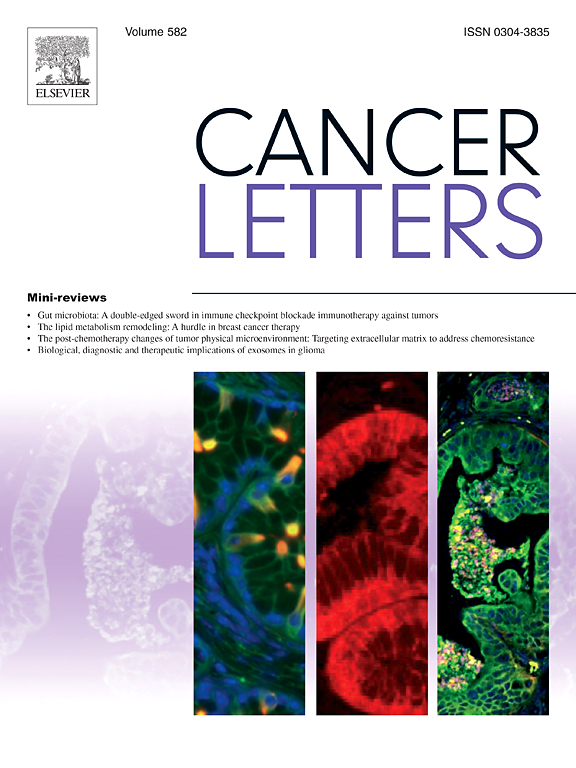单细胞谱鉴定食管鳞状细胞癌免疫化疗的生物标志物。
IF 10.1
1区 医学
Q1 ONCOLOGY
引用次数: 0
摘要
食管鳞状细胞癌(ESCC)仍然是一种高度侵袭性的恶性肿瘤,治疗选择有限。虽然免疫检查点阻断(ICB)联合化疗改善了结果,但耐药机制和预测性生物标志物尚不清楚。本研究旨在描述ICB治疗期间肿瘤微环境(TME)的动态变化,并确定与治疗反应相关的细胞群和分子程序。我们对新辅助camrelizumab(抗pd -1)加化疗治疗的27个样本(22个配对的治疗前后肿瘤,2个未配对的肿瘤和3个邻近组织)中的174,223个细胞进行了scRNA-seq, scTCR-seq和scBCR-seq。ICB治疗重塑了TME,增加了CXCL12+炎性成纤维细胞和CD1C+树突状细胞,同时减少了中性粒细胞和浆细胞。耐药相关的特征包括具有部分上皮-间质转化(p-EMT)程序的恶性细胞、DES+肌成纤维细胞、FOLR2+巨噬细胞和表现终末衰竭的克隆扩增CD8+ T细胞。另一方面,应答者拥有更多的RGS13+生发中心B细胞。本研究揭示了ICB治疗期间TME的细胞和分子重编程,并确定了ESCC中反应和耐药的生物标志物。这些见解可以潜在地指导患者分层和制定有针对性的策略来克服ICB耐药性。本文章由计算机程序翻译,如有差异,请以英文原文为准。
Single-cell profiling identifies biomarkers for immunochemotherapy in esophageal squamous cell carcinoma
Esophageal squamous cell carcinoma (ESCC) remains a highly aggressive malignancy with limited therapeutic options. While immune checkpoint blockade (ICB) combined with chemotherapy has improved outcomes, resistance mechanisms and predictive biomarkers are poorly understood. This study aims to characterize the dynamic changes in the tumor microenvironment (TME) during ICB treatment and identify cell populations and molecular programs associated with therapeutic response. We performed scRNA-seq, scTCR-seq, and scBCR-seq on 174,223 cells from 27 samples (22 paired pre- and post-treatment tumors, 2 unpaired tumors, and 3 adjacent tissues) treated with neoadjuvant camrelizumab (anti-PD-1) plus chemotherapy. ICB treatment reshaped the TME, increasing CXCL12+ inflammatory fibroblasts and CD1C+ dendritic cells while reducing neutrophils and plasma cells. Resistance-associated features included malignant cells with partial epithelial-mesenchymal transition (p-EMT) programs, DES+ myofibroblasts, FOLR2+ macrophages, and clonally expanded CD8+ T cells exhibiting terminal exhaustion. On the other hand, responders harbored more RGS13+ germinal center B cells. This study reveals the cellular and molecular reprogramming of the TME during ICB therapy and identifies biomarkers of response and resistance in ESCC. These insights could potentially guide patient stratification and the development of targeted strategies to overcome ICB resistance.
求助全文
通过发布文献求助,成功后即可免费获取论文全文。
去求助
来源期刊

Cancer letters
医学-肿瘤学
CiteScore
17.70
自引率
2.10%
发文量
427
审稿时长
15 days
期刊介绍:
Cancer Letters is a reputable international journal that serves as a platform for significant and original contributions in cancer research. The journal welcomes both full-length articles and Mini Reviews in the wide-ranging field of basic and translational oncology. Furthermore, it frequently presents Special Issues that shed light on current and topical areas in cancer research.
Cancer Letters is highly interested in various fundamental aspects that can cater to a diverse readership. These areas include the molecular genetics and cell biology of cancer, radiation biology, molecular pathology, hormones and cancer, viral oncology, metastasis, and chemoprevention. The journal actively focuses on experimental therapeutics, particularly the advancement of targeted therapies for personalized cancer medicine, such as metronomic chemotherapy.
By publishing groundbreaking research and promoting advancements in cancer treatments, Cancer Letters aims to actively contribute to the fight against cancer and the improvement of patient outcomes.
 求助内容:
求助内容: 应助结果提醒方式:
应助结果提醒方式:


